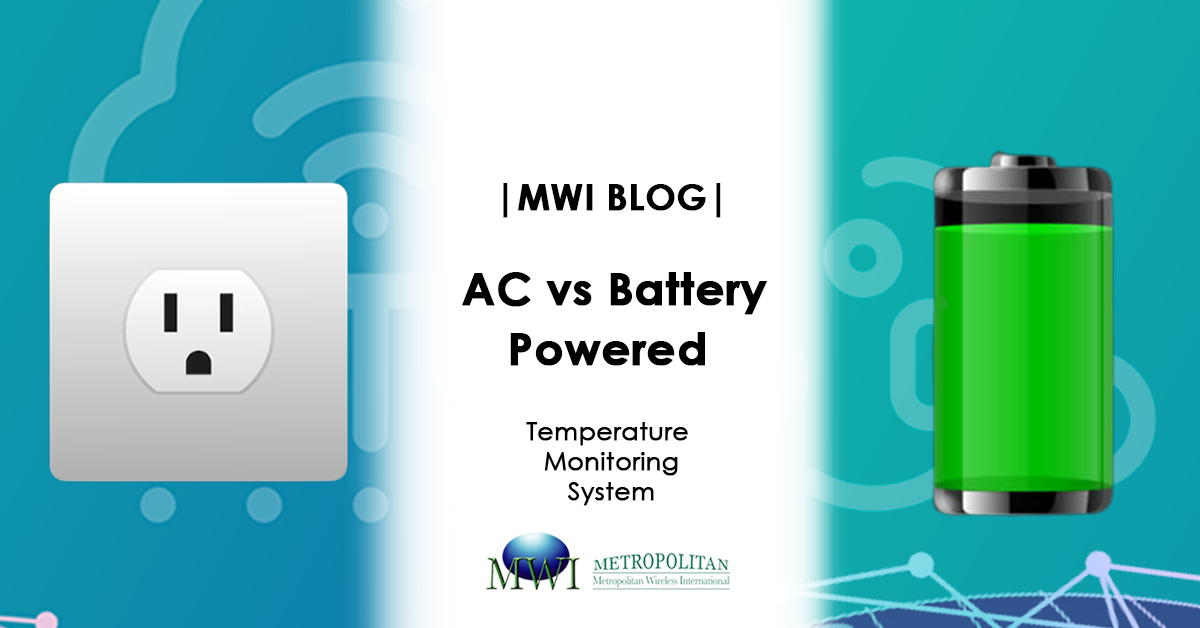Background
Temperature monitoring holds significant importance in various industries as it maintains the integrity of assets. When it comes to deciding between AC-powered and battery-powered temperature monitoring systems, businesses often ponder on this. Each option carries its own set of pros and cons, prompting businesses to evaluate and determine the most suitable choice that aligns with their preferences and specific needs.
A battery-powered temperature monitoring system, such as MWI’s, utilizes sensors powered by batteries, whereas an AC-powered temperature monitoring system utilizes sensors that require connection to a power outlet. This distinction lies in the types of sensors each system employs to start monitoring and capture ambient temperatures of the equipment/area.
Let’s dive into the pros and cons of AC-powered and battery-powered temperature monitoring systems to help you make an informed decision.
AC-Powered vs Battery-Powered Temperature Monitoring System
1. Sensor Placement
Battery-powered monitoring system
Battery-powered sensors can be placed in areas that are challenging to access, which AC-powered sensors will find it difficult to reach. Battery-powered sensors can also be moved/ relocated to different places, without there being such a hassle of rewiring.
AC-powered monitoring system
An AC-powered sensor has to be placed in an area with an available power socket. They would also not be able to relocate as easily as battery-powered sensors.
2. Power Source
Battery-powered monitoring system
Since this type of sensors uses batteries for power, there would need to be battery changes or recharging to maintain continuous ambient temperature monitoring.
Battery consumption and lifespan is also dependent on the frequency of data transmission to the gateway. Because of this, there has to be monitoring of the battery percentage once in a while to ensure the sensor’s ongoing capability to function and oversee temperature conditions within the designated equipment/area.
AC-powered monitoring system
With the sensors plugged into a power socket, there is a lower likelihood of monitoring disruptions as they continuously draw power from the socket itself. This feature offer businesses the advantage of not needing to be concerned about potential monitoring lapses or interruptions.
3. Installation
Battery-powered monitoring system
The utilization of battery-powered sensors simplifies the installation process by eliminating the requirement for a power socket. This approach proves to be beneficial in scenarios where there is an absence of power outlets in the monitored equipment/area. By freeing the installation process from the constraints of plug availability through the use of a battery-powered system, businesses can effortlessly set up monitoring systems without incurring extra costs.
AC-powered monitoring system
The usage of AC-powered sensors would mean that there is a need for there to be a power socket available in the equipment/area. Without the socket, the sensors would not be able to operate and monitor the ambient temperatures. This would mean that businesses have to incur additional costs to be able to use this sensor and system.


4. Initial Costs
Battery-powered monitoring system
For certain businesses, adopting a battery-powered temperature monitoring system might be costly to them at first. These costs are due to the specialized hardware and the wireless structure in the sensors, which are essential for effective operation. There is also no additional costs on the business as the monitoring system is usually a plug and play, which makes it easy to install.
AC-powered monitoring system
AC-powered monitoring systems might have a lower initial cost compared to battery-powered monitoring systems. However, this system might require professional installation if they need to be connected to electrical wiring, which will add up to the initial costs of the whole system.
Summary
These are some of the differences between an AC-powered monitoring system and a battery-powered monitoring system. While each system possesses its own pros and cons, a business should choose a monitoring system that fits their requirements and preferences.


